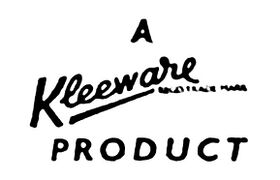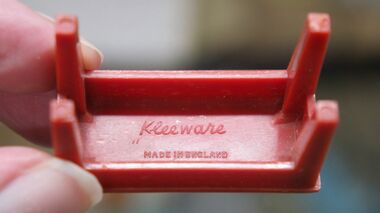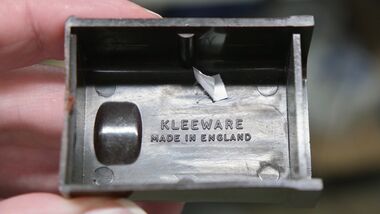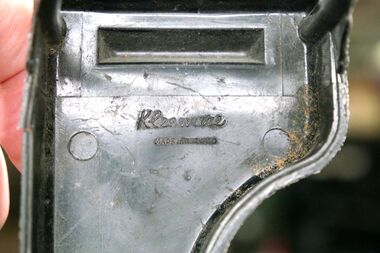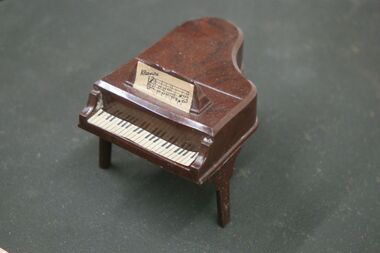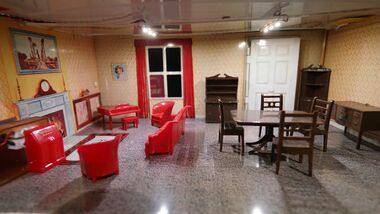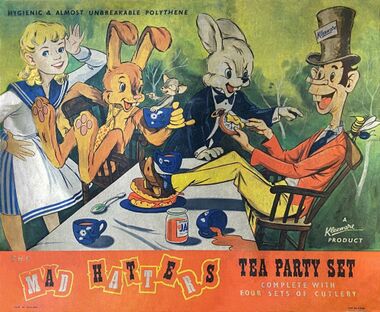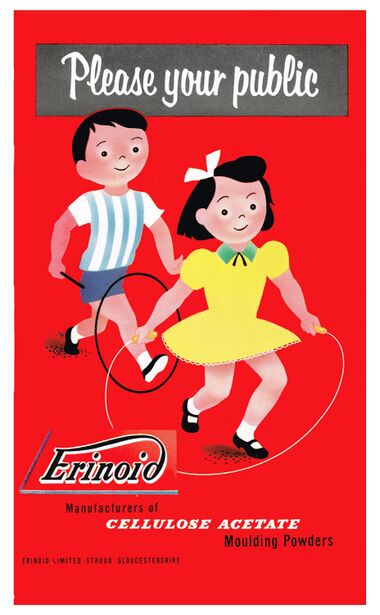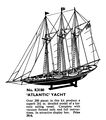Category:Kleeware
| Toy Brands and Manufacturers |
|---|
Kleeware |
| 1938 - 1959 |
Bench underside, showing Kleeware logo [image info]
TV Set rear/interior, showing KLEEWARE name [image info]
Piano (wood effect), showing Kleeware logo on its sheet music [image info]
Kleeware dollhouse piano, with the Kleeware script logo printed on its sheet music [image info]
Dining-Room and Lounge Sets, Kleeware for Mettoy [image info]
Mad Hatter's Tea Party Set, "Hygienic and almost unbreakable polythene" [image info]
1956: Erinoid Limited, cellulose acetate moulding powders [image info]
O and M Kleeman Limited was a plastics and plastic toy company founded in 1938 that is mainly remembered for their cheap and popular "pocket-money" Kleeware dollhouse furniture (sold through outlets like Woolworths). Manufacturing took place in Welwyn Garden City, and, when expansion later caused them to require larger premises, in Aycliff, County Durham.
Plastics raw materials manufacturing
Kleeman also sold "Kabroloid moulding powder" direct to other manufacturers, and after they also took over the "Erinoid" business, decided to concentrate on just supplying raw materials to industry (which eliminated the awkwardness of supplying raw plastics to toy companies, and then competing with those same companies as a toymaker themselves).
In the history of British toymaking, brands tend to disappear when their owning companies go bust or are bought out – Kleeman's exit from toymaking is an unusual example of a toy brand disappearing becuase the company was too successful (in other areas). Kleeman disposed of their toymaking business by selling the "product manufacturing" side to their competitor toymaker Rosedale (owner of the "Tudor Rose" brand) in 1959.
Kleeware Plastics Limited posted notices for the winding up of the company in the London Gazette in early-to-mid 1965.
Range
Kleeware (like Airfix and Palitoy) were a plastics company that originally used the new materials to produce all manner of small household and personal goods. After a diversion to war work during World War Two (1939-45), Kleeware's inventory of small plastic items grew to include small dolls (as did Palitoy), plastic kits (as did Airfix) and other miscellaneous toys, and ... unlike the other two mentioned companies ... plastic dollhouse furniture.
The kits (such as the aeroplane kits and the "Model Cars of All Nations" series) seem to have been licenced from small US kit manufacturers, who, while not able to finance selling into the UK market themselves, were prepared to hire out their moulds to a "local" manufacturer.
Dollhouse furniture
The obvious advantage of using plastic moulding for dollhouse items was that many pieces (like tables and chairs) were simple single-colour pieces with no moving parts, that could be considered to be "finished" as soon as they plopped out of the injection moulding machine. However, some of their pieces were multipart (such as a plastic kitchen chair with a different-coloured plastic cushion).
Quality-wise, Kleeware's output ranged from well-sculpted brown wood-look furniture with a hard, opaque, almost Bakelite-like glossy finish, to cheaper, designed-to-cost "penny toys set" -style pieces with no stamped brand name, moulded in softer, cheaper-looking plastic. Their cheapest items are (perhaps unfortunately) the easiest to recognise, typically one-piece "shell" items with no moving components and hollow bases, moulded in white, red, yellow or pink.
Addresses
- O & M Kleeman Limited – Mappin House, 156-162 Oxford Street, London, W1
- O & M Kleeman Limited – West Halkin House, West Hlkin Street, London W1 -- 1952
External links
- O. and M. Kleeman, Graces Guide (gracesguide.co.uk)
- Kleeware in Pictures (planetdiecast.com)
- Kleeware (wikipedia.org)
museum collections:
- Kleeware, Museum of New Zealand (collections.tepapa.govt.nz)
- Kleeware, V&A (collections.vam.ac.uk)
- Kleeware, Museum collections, Wakefield Council (collections.wakefield.gov.uk)
- Kleeware, National Trust Collections (nationaltrustcollections.org.uk)
misc ranges:
- Kleeware "Littletown" buildings (binnsroad.co.uk)
- Plasticville USA: Kleeware (plasticvilleusa.org)
- Littletown/Plasticville (cs.trains.com)
- K is for Kleeware (smallscaleworld.blogspot.com)
- Kleeman model aircraft kits, Unofficial Airfix Modellers' Forum (uamf.org.uk)
- Kleeware brand kits (hobbydb.com)
- Kleeware Garage with cars (oldclassiccar.co.uk)
Subcategories
This category has the following 4 subcategories, out of 4 total.
K
- Kleeware for Mettoy (6 P, 11 F)
L
- Littletown (empty)
Pages in category ‘Kleeware’
The following 12 pages are in this category, out of 12 total.
B
Media in category ‘Kleeware’
The following 30 files are in this category, out of 30 total.
- Atlantic Yacht, Kleeware kit K3180 (Hobbies 1960).jpg 2,372 × 2,676; 664 KB
- Atlas Missile, Kleeware kit K9125 (Hobbies 1960).jpg 1,762 × 2,420; 382 KB
- Bald Eagle, Kleeware kit K1533 (Hobbies 1960).jpg 2,360 × 1,900; 319 KB
- Bathroom set (Kleeware for Mettoy).jpg 2,504 × 1,606; 337 KB
- Bedroom set (Kleeware for Mettoy).jpg 2,504 × 1,606; 418 KB
- Bench, underside showing branding (Kleeware).jpg 3,000 × 1,684; 542 KB
- Boeing 707 Strato Tanker, Kleeware kit K9119 (Hobbies 1960).jpg 2,731 × 1,710; 381 KB
- Box base, Mettoy Dolls House Furniture (Kleeware for Mettoy).jpg 1,241 × 1,600; 279 KB
- Dining Room and Lounge (Kleeware and Mettoy, 1950s).jpg 3,000 × 1,690; 637 KB
- Dining Room set (Kleeware for Mettoy).jpg 2,504 × 1,606; 405 KB
- Dolls House Furniture, box lid graphic (Kleeware).jpg 3,000 × 2,389; 1.71 MB
- Kitchen set (Kleeware for Mettoy).jpg 3,732 × 1,606; 556 KB
- Kleeware Plastic Construction Kits (Hobbies 1960).jpg 1,200 × 855; 279 KB
- Kleeware Product logo bw.jpg 578 × 371; 31 KB
- Lounge set (Kleeware for Mettoy).jpg 2,504 × 1,606; 419 KB
- Mad Hatters Tea Party Set, box lid (Kleeware).jpg 2,000 × 1,642; 688 KB
- Marilyn M North Atlantic Trawler, Kleeware kit K1516 (Hobbies 1960).jpg 3,000 × 1,918; 530 KB
- Metal Dollhouse and plastic furniture (Mettoy).jpg 3,000 × 2,137; 999 KB
- Mettoy Dolls House Furniture (Kleeware for Mettoy).jpg 1,600 × 1,244; 182 KB
- Mettoy Playthings, logo (Kleeware for Mettoy).jpg 1,200 × 697; 94 KB
- Nursery set (Kleeware for Mettoy).jpg 3,732 × 1,606; 607 KB
- Piano, underside showing branding (Kleeware).jpg 3,000 × 2,000; 1.02 MB
- Piano, wood-effect, with sheet music (Kleeware).jpg 2,000 × 1,334; 309 KB
- SS United States, Kleeware kit K3173 (Hobbies 1960).jpg 3,000 × 1,522; 496 KB
- Television Set, interior showing branding (Kleeware).jpg 3,000 × 1,688; 501 KB
- The Bathroom Set (Kleeware).jpg 1,800 × 1,066; 833 KB
- The Bedroom Set (Kleeware).jpg 3,000 × 1,214; 1.23 MB
- The Dining Room Set (Kleeware).jpg 3,000 × 888; 1.04 MB
- The Kitchen Set (Kleeware).jpg 1,800 × 1,088; 958 KB
- The Sitting Room Set (Kleeware).jpg 3,000 × 1,223; 1.29 MB
